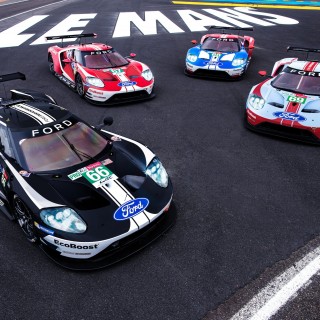
The Porsche 917 sports prototype is often cited as the greatest and most evocative race car ever, due to a combination of its on-track dominance, beautiful looks and that it raced in a legendary sportscar era with legendary drivers. The 917 also celebrates it 50th birthday this year.
And Porsche has just by chance rediscovered an even more striking potential version of it, in the form of a 1:4 scale studio model from 1970. It represents an alternative design for what became the 917/20 ‘Pink Pig’. It was never built as a car proper, yet the model design looks futuristic even almost half a century on, with a sleek and aggressive aerodynamic body and no wheel cutouts.
It’s now on show to the public for the first time, as part of the ‘Colours of Speed—50 Years of the Porsche 917’ special exhibition, which is running at the Porsche Museum in Stuttgart until September 15.
The model for decades subsequently was displayed in the staircase to the basement of ‘the Hexagon’, a large Porsche office building in Weissach, where Porsche’s design department studio was located. “Over the decades, the model just became part of the furniture and I no longer consciously paid any attention to it. It was just there,” said Porsche designer Anthony-Robert ‘Tony’ Hatter. Then when the department moved to a new building, around three-and-a-half years ago, the model got sidelined. “As part of the move, we took it down and put it somewhere. It was only recently that we found it in an old garage,” Hatter continued. “The designers were really looking to the future with this model.”
The design and model came into being as in mid-1970 Porsche sought a development of the 917’s short-tail version, to create an equivalent of the long-tail model with its reduced air resistance, and employed a two-pronged approach. One team worked at the SERA wind tunnel in Paris, while another team worked in-house under Porsche designer Richard ‘Dick’ Söderberg. It was the SERA team’s design that was built in 1971, becoming the famous ‘Pink Pig’ Le Mans racer. Söderberg’s team came up with the more radical design.
“The design language of Richard Söderberg’s creation was far more aesthetic and elegant than the SERA development, but this model proved to be not all that good in the wind tunnel, especially in terms of uplift,” said Hermann Burst, who worked on the SERA version. “Although there was no follow-up order and the decision to build the SERA design had already been made internally, we decided to revise the model aerodynamically anyway.”
Various changes were made to the design, resulting in better wind tunnel numbers. Then the model was improved visually with input from several Porsche designers, piece by piece moving it away from the look of more typical Porsche racers’ of the time.
And while the model’s looks were striking enough from the outside, its interior was just as science fiction, featuring a screen on the left-hand side on the cockpit and a computer with a tape or disk drive on the right. The model even has removable glass—another thing unusual for 1970—to allow people to peer inside.
The amazing design and innovative features were neglected for years afterwards though, its only obvious influence on the instrument panel layout in the Porsche 928 launched in 1977. The following year this 917 reappeared briefly as the cover image for an article named ‘Porsche: the car of tomorrow’, eight years on from its creation still being a visual encapsulation of a futuristic design!
Images courtesy of Porsche/Max Leitner













